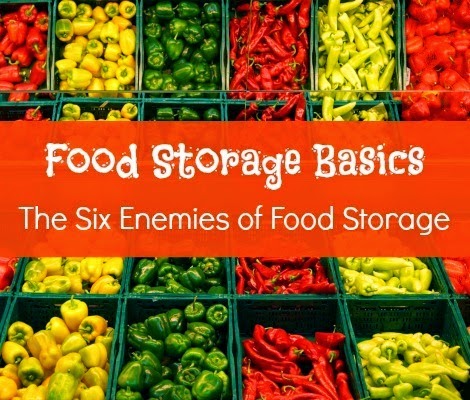Survival Basics: The Six Enemies of Food Storage
When it comes to stockpiling survival preps, two items are always near the top my list: food and land to grow food. Those, in my opinion, are the two most valuable commodities to have if the world and society goes to heck. As I say that, I realize that the land portion of that equation may be unattainable for many. On the other hand, almost everyone can acquire food and a place to store it.
By now you have read over and over again ad nauseam that during a disaster or a SHTF disruptive event, the grocery store shelves will be barren within a day or two. In addition, there is a strong likelihood that amenities such as electricity and refrigeration will no longer be available. That’s why having food, and an extensive knowledge of food storage techniques, is so important to long-term survival.
Widget not in any sidebars
Since the beginning of Backdoor Survival, I have explored many areas of preparedness, from basic preps, to more extensive studies of self-sufficiency and the psychological aspects of survival. Beyond all else, however, I have taken a keen interest in food and food storage.
With the rapid escalation of food prices, I want to reintroduce you to the six enemies of food storage. They are important to understand and, even if they are sometimes unavoidable, the six enemies are good to keep in mind as you invest in food for your prepper pantry.
The Six Enemies of Food Storage
Storing food for the long term is a daunting task. For the short term, you can usually find a spare shelf or two in your kitchen cabinets and call it a day. Beyond the short term, things start to get more complicated. The reason is that most food products have a shelf life which is pretty much limited by some common factors, referred to as the Six Enemies of Food Storage:
Oxygen
Moisture
Light
Pests
Time
As you will see, each of these factors are interrelated in such a way that there is a domino effect with all of the tiles falling upon each other and ultimately affecting your stored items in a cumulative fashion. I will briefly address each one so that this becomes clear.
Temperature: Long-term food storage is best achieved by maintaining cool, constant temperatures. Ideally, temperatures between 40 degrees and 70 degrees Fahrenheit are best for long-term storage. Anything warmer or cooler results in loss of color, nutrition, texture and taste. A common rule of thumb is that for every 18 degree Fahrenheit increase in temperature (10 degrees Celsius), your food’s shelf life is cut in half.
The second factor when it comes to temperature is consistency. So if you have a location where the temperature is 40 degrees one day and 70 the next, there is going to be some loss in quality and shelf life. Let me put this another way. If you have stored your food in a garage where the temperature fluctuates between summer and winter, the shelf life will be based upon the highest temperature not the lowest.
Oxygen: Many food nutrients can oxidize in the presence of oxygen. This creates rancidity and off flavors. In addition, bacteria and microorganisms (larvae and bugs) thrive in an oxygen-rich environment. Fortunately, the use of oxygen absorbers can suck out the oxygen in your food containers, leaving only product and nitrogen (which is not harmful).
Moisture: Moisture comes in many forms, but the most typical are humidity and condensation. When stored food becomes moist or even slightly damp, molds and bacteria begin to grow, causing spoilage. If this food is consumed, illness will occur. In addition, moisture can cause packaging to break down, exposing the food to further degradation.
The ideal level of humidity for your stored food is 15% or less. I live in Washington State where the humidity is typically 60% or 70% or more. The way around the humidity and moisture issue is proper packaging. And with packaging, there are lots of choices including Mylar bags, food-grade buckets with or without gamma seals, vacuum seal bags (such as the FoodSaver), Mason or canning jars and more.
 What you decide to use to package your food will dictate how much light your food is exposed to (remember those dominoes?)
What you decide to use to package your food will dictate how much light your food is exposed to (remember those dominoes?)
Light: The easiest way to explain how light affects your stored food is to equate light to energy. When the energy of light zaps your food, it transfers some of that energy to the food itself, degrading its nutritional value, taste and appearance. This is especially true when it comes to the fat soluble vitamins such as Vitamins A, D and E as well as proteins.
Pests: Pests are another problem. Moisture and humidity provide a breeding ground for bugs and larvae of all types. Pests come in many forms. From bugs to rodents, pests are not only a nuisance, but also a major factor to eliminate when storing food for the long term.
It is important to be aware of the pests that are particular to your geographical climate and, further, that you set a barrier between your food and the critters. In addition to a physical barrier, the use of oxygen absorbers or diatomaceous earth will eliminate the oxygen (air) that most pests need to survive.
Time: Over time, food will degrade in nutritional value, appearance and taste. Time is the final enemy of food storage. And while there are many items that have an extended shelf life of 20 or 30 years, unless they are properly packaged and stored, the optimal shelf life will be considerably less. If you really do desire products with a 30-year shelf life, I suggest you look at some of the commercially packaged alternatives at Emergency Essentials, Buy Emergency Foods, and others. These days you can even find products packaged for 20- or 30-year storage at Wal-mart and Costco.
Resources to Mitigate the Enemies of Food Storage
Once you understand the six enemies of food storage, the challenge is to learn to store food in such a way that these issues are mitigated. The easiest and most manageable method for storing food for the long-term is to use Mylar bags, food grade buckets, and mason jars (if kept in a dark place) in conjunction with the use of oxygen absorbers.
Here are some articles tips to help you package your food products for the long term.
Survival Basics: Using Mylar Bags for Food Storage
Survival Basics: Buckets, Lids and Gamma Seals
How to Use a FoodSaver for Vacuum Canning
You will find that once you get started, it is pretty easy to package up bulk food items yourself and while you may not be able to avoid fluctuations in temperature, your food will still be viable for longer than those items left in their original store packaging.
The Final Word
The intent of this article is to give you a top level overview of the considerations you need to keep in mind as you begin to acquire food products for long term storage.
Enjoy your next adventure through common sense and thoughtful preparation!




